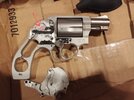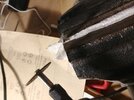While there have been credible reports of malfunctions with both exposed hammer and hammerless designs, a variety of calibers, and frames made from all the various materials (steel, aluminum, Scandium), a fairly consistent pattern has emerged in the majority of confirmed lock failures. In general, the guns most susceptible to self-engagements have been exposed hammer guns, with frames made of lightweight materials (particularly Scandium), firing large caliber rounds (.44 Magnum, in particular) or high pressure, smaller caliber rounds (such as .357 Magnum or .38 Special +P+).
In practice, the locking piece (that doubles as a “LOCKED” flag on the exposed hammer guns) is under very minor spring tension, from a small coil spring at its base. Under the severe forces of recoil in lightweight, heavily-charged guns, inertia has allowed the locking piece to “float up” into a raised position and bind on the hammer, locking it in place. Sometimes this malfunction can be cleared in the field, but other times the jam has been severe enough that it required disassembly of the revolver and/or the attention of a trained gunsmith.
Because the locking piece is bigger on the exposed hammer guns, to incorporate the visible flag, there seems to be a greater tendency for these guns to jam up than on the hammerless models, where the locking piece is smaller and has less inertia to overcome the coil spring tension.






